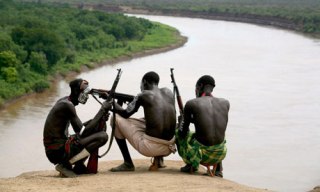Hundreds of groups join in protest against Ethiopia’s mega-dam
By Tesfa-Alem Tekle
March 30, 2011 (ADDIS ABABA) – Some 400 organisations from across the world have signed a petition against the construction of Ethiopia’s multi-billion dollar Gibe III Dam project, Survival International has told Sudan Tribune.

“We have delivered the petition on 22 March, to Ethiopian embassies or representatives in France, Germany, Italy, Belgium, the UK and the USA,” she said on Wednesday.
Survival International says construction of the dam will devastate the fragile ecosystem of the area by altering the seasonal flooding of the Omo River and reducing its downstream volume, resulting in the drying out of the land endangering the lives of 500,000 people along the lower Omo Valley and Kenya’s Lake Turkana.
For these reasons, the group strongly argues construction of the dam must be halted and funds must stop.
“The Ethiopian government claims that 40% of the dam has been built – and yet they still have not consulted the Omo Valley tribes – this is against international standards and in violation of Ethiopian law. If the Ethiopian government applied its own laws and respected its own citizens, construction could halt tomorrow”, Shenker said.
“Moreover the government needs to find funding to carry on with the dam The European Investment Bank and the African Development Bank have decided against funding the dam.”
Currently, the Industrial and Commercial Bank of China and the Exim Bank of China are both funding aspects of the project but Ethiopia still needs to find more money. The Italian government is still considering whether to fund the dam.
Despite growing outrage from environmental groups, the Ethiopian government however disagrees on the claims and insists it will continue the project with or without foreign funds.
Addis Ababa says that the hydroelectric dam will not damage the environment and the water is only needed to generate electricity and will not affect its flow.
According to Ethiopian officials, the power generated out of it will be used for its population and to sell power to neighboring countries, including Kenya.
Campaigners also argue that the dam could trigger a resource-based conflict between communities living around the Kenya-Sudan-Ethiopia border.
Kenya signed a memorandum of understanding with Ethiopia to receive significant amounts of electricity to be generated by Gibe 3. However, following sustained campaigning from Kenyan organizations, the Kenyan government has begun to investigate more carefully the likely impacts of the dam on Kenyan communities living around Lake Turkana. Part of the problem with Gibe 3 is that construction began well before any real studies on the human impact of the dam were carried out – good information on this is still hard to come by.
‘‘We have received reports that there are some people in the Kenyan government who are very concerned about Gibe 3 dam and especially the impacts it will have on Lake Turkana and the peoples in that region. Last year it announced that it would commission an independent EISA on the impact of the dam on Lake Turkana”, the researcher said.
“We hope that the Ethiopian government will uphold its own constitution and hold proper and meaningful consultations with all the tribal people who will be affected by Gibe 3, as well as heed a growing body of experts and funders who believe the social and environmental impacts of Gibe 3 dam outweightoutweigh whatever benefits it may bring to the nation’’.
According to Shenker , Survival International is not against industrialization, nor against dams. But she said that such projects must only happen with the full, free, and prior consent of the people who will be most affected.
Survival International’s director Stephen Corry said in an email: ‘If the government dams the Omo Valley tribes’ water and parcels off their land to outsiders, these peoples may not survive. The government is pushing industrialization at the ultimate expense of the country’s most vulnerable peoples.’
Gibe III is located 450km southwest of the capital, Addis Ababa, near the border with Kenya. It is the largest project of its sort ever to be implemented in Ethiopia and will be Africa’s tallest and second largest hydroelectric dam after the Kariba dam on the Zambesi River between Zambia and Zimbabwe.
Construction of the massive dam was started in 2006 by Italian company, Salini Costruttori. Some 3,000 Ethiopians and foreigners are currently engaged in the project. When it goes operational it will have power generating capacity of 1900MW annually rising the current power supply in the country to 95%.
(ST)
